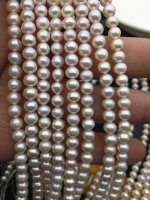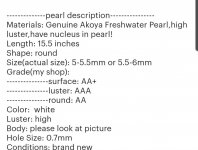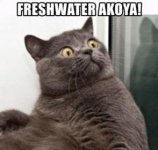You are using an out of date browser. It may not display this or other websites correctly.
You should upgrade or use an alternative browser.
You should upgrade or use an alternative browser.
Chinese freshwater akoya's
- Thread starter Rianne
- Start date
Hi Rianne,
They do look like akoya pearls to me. I'm also pretty sure that the vendor made a mistake by stating that the pearls are grown in freshwater. Chinese akoya are grown in salt water although the quality is albeit lower than their Japanese counterparts.
They do look like akoya pearls to me. I'm also pretty sure that the vendor made a mistake by stating that the pearls are grown in freshwater. Chinese akoya are grown in salt water although the quality is albeit lower than their Japanese counterparts.
Pearl Dreams
Pearl Enthusiast
I suspect they are calling them "akoya" only because they are small nucleated FWP, in other words, small Edison-type pearls. I don't think an oyster that lives in saltwater could be moved to fresh water and survive.
However, it is interesting that there are now small nucleated FWP more generally available. These are not very round. When really round ones are generally available, they will compete with actual akoyas.
However, it is interesting that there are now small nucleated FWP more generally available. These are not very round. When really round ones are generally available, they will compete with actual akoyas.
Last edited:
eolian pearls
Well-known member
Thank you Rianne for posting this question!
I was wondering the same thing as I have seen recently quite a few vendors selling “ freshwater akoyas” that looked quite nice, naturally the higher the price better the shape... Then I have found a listing on Etsy (European vendor) of a nice round akoya necklace with a price tag that made me wonder... I reached out and specifically asked if these were “freshwater akoyas” and they confirmed...saying that the Chinese farmers now use the same oysters to produce akoya in freshwater...which is very hard to believe...
I was wondering the same thing as I have seen recently quite a few vendors selling “ freshwater akoyas” that looked quite nice, naturally the higher the price better the shape... Then I have found a listing on Etsy (European vendor) of a nice round akoya necklace with a price tag that made me wonder... I reached out and specifically asked if these were “freshwater akoyas” and they confirmed...saying that the Chinese farmers now use the same oysters to produce akoya in freshwater...which is very hard to believe...
KarinK
Well-known member
Sounds like it just got more complicated... I wonder how many people are going to end up on PG, having purchased 'akoya' pearls that aren't the real deal and we might not even be able to tell them apart. Or the byers might very well not be able to. All the more reason to buy from reliable and trusted vendors.
- Karin
- Karin
I suspect they are calling them "akoya" only because they are small nucleated FWP, in other words, small Edison-type pearls. I don't think an oyster that lives in saltwater could be moved to fresh water and survive.
However, it is interesting that there are now small nucleated FWP more generally available. These are not very round. When really round ones are generally available, they will compete with actual akoyas.
Interesting info, PD. I thought the smallest nucleated FWP was about 8mm. Smaller FWPs are not nucleated, so I thought. Sigh the pearling technology evolves so fast!
Pearl Dreams
Pearl Enthusiast
I'm looking the matter of salinity in The Pearl Oyster by Paul C. Southgate and John S. Lucas.
On p. 204 it states,
" Salinities for good survival of adult Akoya are ca. > 18%....
Nucleate Akoya are less tolerant of low salinity than normal pearl oysters 2 months after the nucleus is inserted....
There was 37% and 70% mortality of normal and nucleated pearl oysters, respectively, after 36 hours in 9.5% salinity...."
I think this puts to rest the idea that Akoyas can survive in fresh water. They have to be in salt water, of certain levels of salinity, or they die.
I think we can assume that the Chinese have indeed developed their technology and are implanting smaller nuclei into FWP.
On p. 204 it states,
" Salinities for good survival of adult Akoya are ca. > 18%....
Nucleate Akoya are less tolerant of low salinity than normal pearl oysters 2 months after the nucleus is inserted....
There was 37% and 70% mortality of normal and nucleated pearl oysters, respectively, after 36 hours in 9.5% salinity...."
I think this puts to rest the idea that Akoyas can survive in fresh water. They have to be in salt water, of certain levels of salinity, or they die.
I think we can assume that the Chinese have indeed developed their technology and are implanting smaller nuclei into FWP.
CortezPearls
PG Forum Admin
Interesting post...and no, definitively not Akoyas but wanting to ride on the fame of Akoya pearls. There ain't such a thing as: 1) a Free lunch nor 2) Freshwater Akoya.
Like pearl dreams has clearly shared, pearl oysters are MARINE creatures. One of the reasons for the "death" of the Akoya industry in China was the freshwater runoff (after storms) that would come down streams and rivers during the rainy season and alter the salinity levels in the shallow bays...and that was it for the poor Akoya.
Like pearl dreams has clearly shared, pearl oysters are MARINE creatures. One of the reasons for the "death" of the Akoya industry in China was the freshwater runoff (after storms) that would come down streams and rivers during the rainy season and alter the salinity levels in the shallow bays...and that was it for the poor Akoya.
Rianne
New Member
Thank you pareltje (also dutch?) .
I send the vendor a message, they are called Akoya's it's not a mistake in listing. Think i will order a strand to see the different and compair with the Akoya's from Vietnam i have frok cees.
I send the vendor a message, they are called Akoya's it's not a mistake in listing. Think i will order a strand to see the different and compair with the Akoya's from Vietnam i have frok cees.
Rianne
New Member
Thank you pearl dreams!
Eolian, seen it too!
Many jewelry with so called Akoya's and everytime i'm loting for the real deal i pay a lot and my storting cost are still over wat they ask for a necklace...
You are a beader to, di you use them and under which name are you selling them? In doubt to buy a strand, they look bice on picture.
Douglas, thank you! Hear hear! But, when i buy them and use them. How to call these? Just FP?
I'll think judt have to order a strand.
True akoya's, a strand per pearl/bead €20 is way to expancive for now.
Eolian, seen it too!
Many jewelry with so called Akoya's and everytime i'm loting for the real deal i pay a lot and my storting cost are still over wat they ask for a necklace...
You are a beader to, di you use them and under which name are you selling them? In doubt to buy a strand, they look bice on picture.
Douglas, thank you! Hear hear! But, when i buy them and use them. How to call these? Just FP?
I'll think judt have to order a strand.
True akoya's, a strand per pearl/bead €20 is way to expancive for now.
Thank you pareltje (also dutch?) .
I send the vendor a message, they are called Akoya's it's not a mistake in listing. Think i will order a strand to see the different and compair with the Akoya's from Vietnam i have frok cees.
HI Rianne,
I speak Dutch (Flemish actually).
If I were you, I'd buy my pearls from Cees Van Oije since you live in the Netherlands anyway. He's reliable and has an eye for God's quality pearls.
CortezPearls
PG Forum Admin
I agree with Pareltje Rianne.
If you do get them, they are just beaded freshwater pearls.
Have a great day!
If you do get them, they are just beaded freshwater pearls.
Have a great day!
jshepherd
Pearl Paradise
They could be beaded freshwater pearls, but calling them akoya is wrong and just dishonest.
I certainly hope sellers of this new type of pearl don't take the path of dishonesty in the way they describe these things. I've never heard anyone in China calling them "freshwater akoya" in the trade. They know they would be ostracized as dishonest vendors if they did.
The same thing has been going on for years with dyed freshwater pearls when sellers reference Tahitians.
Beaded freshwater pearls in small sizes are now available in China, but they have poor shape and typically poor surface. They are slightly more expensive than tissue-nuked but as far as I've been able to tell at the shows, they're considered an oddity with no real value
I certainly hope sellers of this new type of pearl don't take the path of dishonesty in the way they describe these things. I've never heard anyone in China calling them "freshwater akoya" in the trade. They know they would be ostracized as dishonest vendors if they did.
The same thing has been going on for years with dyed freshwater pearls when sellers reference Tahitians.
Beaded freshwater pearls in small sizes are now available in China, but they have poor shape and typically poor surface. They are slightly more expensive than tissue-nuked but as far as I've been able to tell at the shows, they're considered an oddity with no real value
eolian pearls
Well-known member
I was doing a little research into baby akoya 3-4mm as my sister wanted a pearl chain made of these ( I am an amateur beader only for my family&friends) and first of all the best real deal was very expensive so then I found these “freshwater” akoyas.
During my search I stumbled over a few too good to be true baby akoya necklaces and when I inquired they ended up being the undeclared freshwater ones. The seller saying “no matter they are not saltwater, they are still beautiful...”. Didnt buy any in the end, ( I used smallish metallic rice pearls for the chain ) but as for these “freshwater akoyas” it seemed to me that Kongs’ listings had nicer shapes than Wen’s.
During my search I stumbled over a few too good to be true baby akoya necklaces and when I inquired they ended up being the undeclared freshwater ones. The seller saying “no matter they are not saltwater, they are still beautiful...”. Didnt buy any in the end, ( I used smallish metallic rice pearls for the chain ) but as for these “freshwater akoyas” it seemed to me that Kongs’ listings had nicer shapes than Wen’s.
Pearl Dreams
Pearl Enthusiast
Jeremy, do we know where in the mussel the small nuclei are bing implanted? Is it in the gonad as is the case for Edisons?
StarryPearl
Well-known member
- Joined
- Dec 29, 2020
- Messages
- 370
I recall I have ever read an article saying "Akoya" is just the Japanese pronunciation of that species of oyster, Pinctada martensi, which exists both in Japan and China, therefore Chinese Akoya is totally legit. That article even claims the wild type of that mollusk originates from Guangxi, China. Could be biased. Did they make those oysters adapt freshwater? I don't know.
Pearl Dreams
Pearl Enthusiast
There were akoya oysters in farms in China but they were saltwater, and as Douglas said, they didn't do well due to freshwater runoff diluting the salinity of the water. The book about pearl oysters also specifically states the akoya oysters cannot survive in water of low salinity. I don't see how they could adapt to fresh water.
linda.wald
Well-known member
I saw these, or similar ones labeled "freshwater akoya" and messaged the shop owner to ask what they were. She replied:
hi, is freshwater pearl, used same culture technology as akoya , have nucleus in middle
hi, is freshwater pearl, used same culture technology as akoya , have nucleus in middle
Rianne
New Member
Opinions are clear! The best thing to do is saving up to buy at Cees.
But is Vietnam akoya's the same as the japanese akoya's?
I know Cees have beautiful vietnamees akoya's at least €20 for one pearl. For a complete necklace i need 50-70 pearls
But is Vietnam akoya's the same as the japanese akoya's?
I know Cees have beautiful vietnamees akoya's at least €20 for one pearl. For a complete necklace i need 50-70 pearls
BeadersSecret
Professional Rethreader
Similar threads
- Replies
- 8
- Views
- 2K
- Replies
- 20
- Views
- 1K
- Replies
- 24
- Views
- 2K
- Replies
- 4
- Views
- 1K



